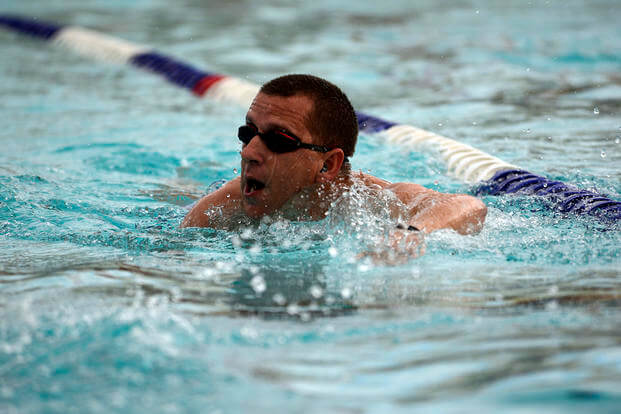Sometimes our go-to cardio option hits a snag with aches, pains, serious injury or illness. When this happens often, it is best perhaps not to do your full workout, but consider some progressions to get back to full form. Here is an email from a retired Navy master chief, who prefers swimming these days to running but injured his shoulder:
Stew, I saw a recent swimming article you did on Military.com for the retired gentleman and loved it. However, I am having some issues with a shoulder injury that is preventing my freestyle [stroke] from working without pain. Do you have any recommendations for other swimming options or strokes, or do I just need to stop swimming for a bit? Thanks for your time, Tom (USN retired)
Master chief,
Thanks for the note, and yes, I have created for you below several options to freestyle swimming that will allow you to stay in the pool as well as find other non-impact options:
- Try treading: Here is an option you can do with legs only or lightly with your arms to work the shoulders in a gentle fashion. Move your arms in a horizontal figure-8 motion with your hands slanted at a 45-degree angle to produce lift. The more you kick, the more you will work your lungs, too, so you can get a cardio benefit as well as a therapeutic benefit with easy arm work.
- Try swimming with fins: If you put on a small pair of slip-on fins, you may be able to do legwork with your normal freestyle stroke. The motion of the water will require less pulling of the arms. You also can just kick for your workout, mixing many different kicks from flutter kicks or dolphin kicks with some kickboard work.
- Try other strokes: If freestyle hurts, consider the breaststroke or the side stroke/combat swimmer stroke, with the injured shoulder doing the shorter stroke and the non-injured arm doing the pulling on the top near the surface.
- Consider other cardio: You also can walk/jog mix if you are able or mix in bike, elliptical machines or rowing machines if the pulling of the arms does not hurt. This option will depend on the joint health of the lower body.
Give some of these a try. You may find that a 30-minute bike or elliptical, followed by an alternative swim, tread or finning workout will be quite sufficient for your training program. However, if these options are causing pain, get the shoulder checked out as you may need surgery or physical therapy.
Stew Smith is a former Navy SEAL and fitness author certified as a Strength and Conditioning Specialist (CSCS) with the National Strength and Conditioning Association. Visit his Fitness eBook store if you're looking to start a workout program to create a healthy lifestyle. Send your fitness questions to stew@stewsmith.com.
Want to Learn More About Military Life?
Whether you're thinking of joining the military, looking for fitness and basic training tips, or keeping up with military life and benefits, Military.com has you covered. Subscribe to Military.com to have military news, updates and resources delivered directly to your inbox.




















